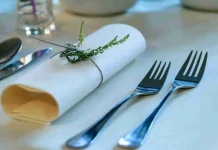Santoku bocho knives or commonly known as Santoku knives are classic Japanese kitchen knives with excellent functionality and versatility. Santoku is a Japanese word that means three qualities, which translates to three uses for mincing, dicing and slicing. It has a small sheep’s foot blade and a straight edge. Although it resembles a Western-style chef’s knife in appearance, it has certain distinct design features. These knives evolved from traditional Japanese vegetable knives with rectangular blades to what they are now.
Some Features of Santoku Knife:
- Wide sheepsfoot blade with no tip.
- Slicing is more polished with a thinner blade than other knives.
- It can be single-sided or double-sided. The surface that has been ground to generate the knife edge is referred to as a bevel.
- Balanced weight and lighter to hold.
- It has Granton edges – small divots/scallops on the blade to keep food from sticking to it.
- It varies in size from 5” to 7.9”
What is a Santoku knife used for?
The Santoku knife is the most popular multipurpose knife. It can be used for a variety of cutting techniques. Here are some examples of how you can use a Santoku knife if you have solid knife skills:
1. Mincing
When making a recipe that asks for minced herbs, garlic, or other items that demand very fine cuts, a Santoku knife is one of the best options.The Granton edge helps minimize stickiness from the blade and avoid shredding delicate herbs (which can affect flavor), while the length and weight of blade provides control between cuts. Place some ingredients on a cutting board and begin mincing them with your santoku knife in a rocking motion. You’ll be able to mince things as thinly and precisely as you want, especially after using a knife sharpener.
2. Dicing
To dice vegetables or fruits, use the cutting edge of a rocking santoku knife. These general-purpose knives’ sharp edges slice through organic materials like air.
3. Slicing
These Japanese knives are ideal for slicing delicate pieces of meat. This is largely due to blades’ thinness and sharpness. A Santoku knife can cut a very thin slice of your favorite fish or vegetable with ease.
4. Chopping
The way you chop with a Santoku knife is very different from other traditional methods. You’ll need to practice it well until you get your hands on it. The blade needs to be removed off the cutting board between each cut because of the flat edge, rather than using the rock chop technique common with Western-style chef’s knives, in which the knife’s tip stays on the cutting board.
5. General cutting
Since the approach for chopping with a Santoku knife differs from traditional procedures, you’ll want to practice until you get the feel of it. As it has a flat edge, you must lift the blade off the cutting board between each cut, rather than using the rock chop technique that is common in Western-style chef’s knives, in which the knife’s tip rests on the cutting board between cuts.
You may also like to Read: What is Nakiri knife used for?
Some Important Santoku Knife Traits
A Santoku knife differs from its Western counterparts in several ways. Let’s have a look at what distinguishes this knife from others:
1. Bevels
In the traditional meaning, Santoku knives have a single bevel (only one side is sharp). Some now have twin bevels (the blade is sharp on both sides) to more nearly mimic the chefs’ knives with which Westerners are more familiar.
2. Curved tip
The santoku blade’s upper side has a curved end rather than a sharp tip. If you’re cutting, dicing, or mincing with a single-bevel santoku knife, this makes it safe to press down on the top of the dull length of the blade.
3. High-carbon steel
The blades of santoku knives are usually made of sharp, high-carbon Japanese steel, whereas the blades of many Western-style knives are made of durable but duller stainless steel. High-carbon steel, especially after knife sharpening, can be extremely powerful, so proceed with caution.
4. Potential indentations
Each knife’s blade shape varies, right down to the little indentations on the sharp edge. Some santoku knives have straight edges, but they’re more likely to have indented or Granton edges—tiny, serrated indentations running the length of the blade—which might help you chop up food faster.
5. Thin blade
Santoku knives have thinner blades than Western-style chefs’ knives, which have wider blades. So, this helps to cut very thin slices of food.
6. Scalloped Edge
The Granton or “scalloped” edge, which refers to the indentations on the blade’s face, is another distinguishing feature of the Santoku blade. Between slices, the Granton edge is meant to keep delicate foods like fish from adhering to the blade. The Santoku knife, like the Western-style chef’s knife, is a multifunctional instrument with numerous applications, making it a must-have in every home kitchen.
7. Push-Cutting
It’s made for the up-and-down chopping motion known as “push-cutting” in Western chef knives. When compared to the rock chop approach employed with traditional chef knives, this technique includes lifting the blade between each cut.
How to Sharpen a Santoku Knife
Knowing how to sharpen your kitchen knives properly takes time and effort to master, especially when it comes to the Santoku knife. Because most Santoku blades are double beveled and sharpening can be a little tricky for a beginner. It’s important to know about the specifications. It’s also crucial to practice, especially when using a whetstone because you’ll need to sharpen each side of the blade at the precise angles. You’ll also need two whetstones, which you should maintain damp throughout the procedure.
Doesn’t it sound like it requires a little effort and a lot of practice? Then how about one of those electric sharpeners for the house? When it comes to your Santoku knife, it’s best to avoid it altogether because it can easily destroy that handy Granton edge. Consider upgrading to the sharpest tools in the kitchen if you don’t want to spend time sharpening your kitchen knives for that matter.
How to Care for a Santoku Knife
The way you take care of your kitchen knives affects how long they stay sharp. After each usage, make sure to hand wash your Santoku knife with warm, soapy water and a soft cloth or gentle brush to remove any residue. Then, before putting it back into a knife block, wipe it totally dry with a towel.
Conclusion
So got cleared with your question that what is santoku knife used for? Finally, knowing when and how to use a Santoku knife is the first step toward getting the most out of it. You’ll see why this is such a popular option among experts and will quickly become one of your favorite cooking tools if you maintain it clean, sharp, and protected from rusting or chipping.
Santoku knives are our favorite because they combine the authenticity and down-to-earthness of Japanese tradition with the accuracy and functionality of German engineering.If you’re used to heavier chef’s knives, you’ll find the santoku to be surprisingly light and comfortable to use. It’s a little smaller than a standard chef’s knife, so it’ll take some time getting used to.












